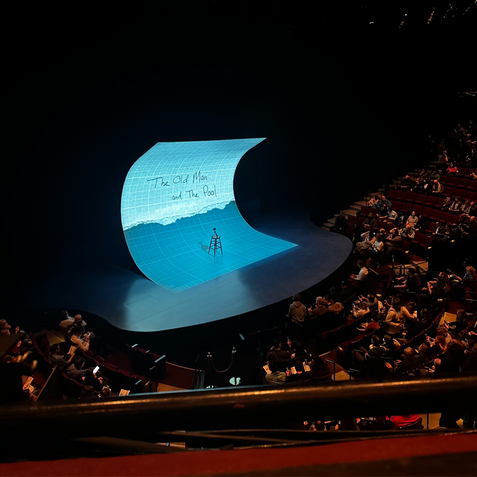Lincoln Center
Lincoln Center Plaza, New York, NY 10023

The first time I ever saw this place was the summer of 2018. That was the summer before my senior year of college. I was a dog walker and as I was headed to one of my clients (a dog), I stumbled upon this plaza.
When Google Maps casually led me through this plaza on the way to my destination, I felt like I had been transported. The city is so cramped, with outdoor space strictly limited to parks, so this vast concrete plaza felt displaced. I was a baby to the city and thought a place that looked this interesting should be more well-known.

Well, it turns out this is literally where Juilliard is. You know, Juilliard? One of the most historic performing arts schools in, dare I say … the world? Not to mention where THE August Rush from the movie August Rush briefly went to school before being kidnapped by a shitbag that just wanted to exploit him for his talent. Chat, is this real? Am I the only one who didn’t know where Juilliard is? This is turning out to be another Radio City Music Hall situation I fear.
When the 1949 Housing Act came into effect, the government pushed fun terms like “domestic investment” and “urban renewal” - AKA “let’s make America great again”. Enter in: Robert Moses (all my homies hate Robert Moses). To give you a better idea about this guy 1) He was New York’s lead urban planner, 2) He’s a known racist, and 3) His motto was “you can’t make an omelet without breaking some eggs”. Similar to Moses from the bible, this guy also likes to part the Red Sea. And by part the Red Sea, I mean displacing thousands upon thousands of people. Yes, if it is to be said, so it be- so it is.

This Moses guy is the main dude behind the tearing down of San Juan Hill to build Lincoln Square, a new development that will house the Lincoln Center of Performing Arts. In order to build this, they had to displace upwards of 30,000 people. Fun, right? “How could they do this??” you ask. “Redlining” I answer. Writing dialogue is my passion. Displacement like this can still be seen today in projects like Manhattanville for Columbia University.

Well… with all that riveting history, aren’t you so excited to learn more about Lincoln Center now?? In all seriousness, I think it’s important to talk about the real history behind New York’s landscape and the involuntary cultural sacrifices made to make the landmarks we know today. I barely scratched the surface of the history here, so if you want to know more I recommend this video:
Not to reference the MCU twice in one week (see: Music of the Month), but Lincoln Center is like the Avengers for performing arts centers. On our team, we have: the New York Philharmonic, the New York City Ballet, the Metropolitan Opera, and Juilliard (seen below)

can you believe August went here???
The center has 30 indoor and outdoor performance facilities including:
David H. Koch Theater: a 2,586-seat theater; constructed as the home of the New York City Ballet
Metropolitan Opera House: a 3,900-seat opera house
David Geffen Hall: a 2,738-seat symphony hall; the home stage of the New York Philharmonic
Vivian Beaumont Theater: a 1,080-seat Broadway theater; where I saw Mike Birbiglia’s The Old Man and The Pool. It was one of the greatest performances I have ever experienced and I highly recommend you watch it on Netflix.

The team of architects is too long for me to go into detail about, so I’ll just focus on one: Phillip Johnson. He is the architect behind the David H. Koch Theater, the original design for the main plaza, and the original Revson Fountain. Johnson specialized in modernist architecture, which focuses on volume, asymmetrical compositions, and minimal ornamentation (aka no gargoyles). Since there were so many architects working on this center, there were a lot of squabbles about the overall design. I think Johnson really carried the team on his back tbh.

Despite its problematic beginnings, Lincoln Center had the mission to make performing arts less snobby and more accessible. Student programs and various grants lowered ticket prices so more people could attend performances. The opening performance at the Metropolitan Opera was headlined by Leontyne Price, a world-renowned black soprano. Also, there were initiatives such as an annual outdoor festival that people could attend for free and gave many smaller artists a platform they wouldn’t have otherwise.

A massive massive MASSIVE!!! shoutout to Katie Gasperian for gifting me this illustration book of various buildings throughout NYC. This is seriously the most thoughtful gift ever and I was so so touched. Here is the artist’s illustration of Lincoln Center!
Fun Facts
San Juan Hill is the neighborhood that inspired West Side Story. The film was originally planned to be filmed in that neighborhood, but construction had already begun.
Behind the facade of the Metropolitan Opera House are two ~30 ft tall symmetrically displayed expressionist murals by artist March Chagall. The Source of Music and The Triumph of Music are inspired by Mozart’s music.
In 2021, the plaza was decked with turf and turned into a public green space. People could lounge, borrow a book from the New York Public Library, or even enjoy the occasional pop-up performance.
























Loved this week's entry! My favorite time of year is the New York Film Festival in October, which is spent almost exclusively at Lincoln Center. I also recently ventured to Damrosch Park which is just behind the Koch Theater (or I guess next to it depending on which direction you look). I love the design in the paving stones.
Phillip Johnson designed some of my favorite buildings (550 Madison, the Glass House in New Canaan, CT, the original interior of the Four Season's restaurant in the Seagram Building. He was quite a contradiction--namely that he was both openly gay and was a Nazi sympathizer in his youth. Jury is still out on whether he actually felt bad about the latter!